Gipsies
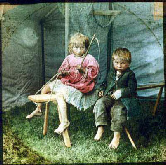 and Vagrants
and Vagrants
These wanderers were accustomed to frequent the waste places around St. Mary Bourne,
Hogdiggen corner between that parish and Whitchurch being one of their favourite
haunts. Here fifty years ago might have been seen, especially during the time of
the revel, a motley group of lean looking men, tawdrily dressed women with bare headed
and shoeless children, baskets of tin ware and trinkets, dogs of mongrel aspect,
donkeys, tent-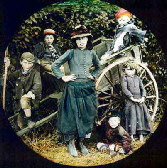 sition to state. According to their tribal
habits they slung their kettle in the pleasant nooks in out of the way places of
the county, their cattle running free and often pasturing on the common lands used
by the English cotters. The leader at that time was known as "Old Tom Black”. He
was a stout made sturdy fellow, who with his brothers frequented the fairs and revels
then in vogue; and it was remarkable how accurate was his knowledge concerning the
dates and other particulars of every feast, Fair and revel throughout Berkshire and
the adjoining counties. The older members excelled at "Single stick”, or "Backsword
playing”, and it was their habit to practise their skill against the sapling oaks
that grew in proximity to their tents, in the absence of a living opponent.
sition to state. According to their tribal
habits they slung their kettle in the pleasant nooks in out of the way places of
the county, their cattle running free and often pasturing on the common lands used
by the English cotters. The leader at that time was known as "Old Tom Black”. He
was a stout made sturdy fellow, who with his brothers frequented the fairs and revels
then in vogue; and it was remarkable how accurate was his knowledge concerning the
dates and other particulars of every feast, Fair and revel throughout Berkshire and
the adjoining counties. The older members excelled at "Single stick”, or "Backsword
playing”, and it was their habit to practise their skill against the sapling oaks
that grew in proximity to their tents, in the absence of a living opponent.
The association of the gipsies with pleasant English scenery, the picturesque character of their lives, and their animal beauty have at all times rendered them the favourite subjects of the painter and poet; but the latter takes a liberty with even their degraded habits when he states the summary of their food as,
"Flesh obscene of dog Or vermin, or at best of cock purloin'd From his accustomed perch"
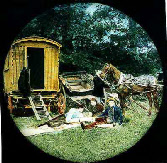 To the last, however, no exception can be brought, while the first is never eaten,
as few fare better than the gipsies. But the hedgehog and the cock were not infrequent
dishes, and were sometimes cooked in
To the last, however, no exception can be brought, while the first is never eaten,
as few fare better than the gipsies. But the hedgehog and the cock were not infrequent
dishes, and were sometimes cooked in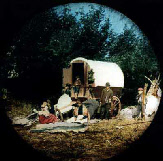 their integuments, the plan being adopted probably
in times of scarcity, or when secrecy was necessary, and it might be a survival of
a method once general. The process consisted of placing the animal on embers in a
hole in the earth, and covering it well with more embers, and over these placing
a sod of turf, and banking the sides well up with embers and ashes. The skin retained
the moisture without any extraneous covering; and the method had the advantage in
the case of poultry that the feathers told no tales. In some cases the hedgehog was
skinned and enveloped in a coat of wet clay before being consigned to the glowing
embers; it was then said to be peculiarly savoury when cooked. (Dr. Joseph Stevens)
their integuments, the plan being adopted probably
in times of scarcity, or when secrecy was necessary, and it might be a survival of
a method once general. The process consisted of placing the animal on embers in a
hole in the earth, and covering it well with more embers, and over these placing
a sod of turf, and banking the sides well up with embers and ashes. The skin retained
the moisture without any extraneous covering; and the method had the advantage in
the case of poultry that the feathers told no tales. In some cases the hedgehog was
skinned and enveloped in a coat of wet clay before being consigned to the glowing
embers; it was then said to be peculiarly savoury when cooked. (Dr. Joseph Stevens)
(Hogdigging corner is now named Dirty corner, so named because in years past the night soils were deposited there from other hamlets, perhaps to disperse the gipsies?) (Kevin Holdway)
- Entries in the parish book relating to vagrants
- 1729-
- Apl.ye 9th. Agreement by the masters of ye parish that there shall be no use money given out of the church or poor book to any vagrants or traveller by any officer of ye parish. - 1741-
- pd. vagabond money £6.16s.3d. - 1742-
- Gave to travellers with the pass at several times 7s.
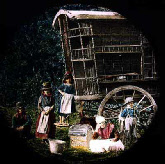 Although the dates of these entries are later than the time when the stocks and whipping
post were in chief demand for the punishment of vagrants, their employment was frequent
down to a period later than the dates. In ancient times vagrancy was a penal offence
punishments included whipping at a cart's tail or in the stocks, till the backs were
bleeding, cutting out the gristle of the ear, branding with the letter V, (vagabond),
imprisonment on bread and water, and even death. (Dr. Joseph Stevens)
Although the dates of these entries are later than the time when the stocks and whipping
post were in chief demand for the punishment of vagrants, their employment was frequent
down to a period later than the dates. In ancient times vagrancy was a penal offence
punishments included whipping at a cart's tail or in the stocks, till the backs were
bleeding, cutting out the gristle of the ear, branding with the letter V, (vagabond),
imprisonment on bread and water, and even death. (Dr. Joseph Stevens)
Forty years ago it was a common practice for beggars to present themselves at the
back doors of houses, exhibiting ugly looking sores and distorted limbs to excite
charity. The limbs were
awkwardly bandaged, in a crooked manner, intended to convey
the idea that the limbs were diseased, when they were only purposely distorted. The
sores I afterwards found were kept open by means of an
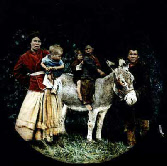 application made from the
common Mezereon (Daphne Mezereum), a plant which was then found wild in the Hampshire
woods; but which has since been in a great measure exterminated, by the shrub being
used as an ornament in shrubberies and gardens. These "artful dodgers" had, as beggars
generally have now, a series of marks, or hieroglyphics, to denote to their fellows
coming after them what was the character of the inmates of houses so marked, in so
far as they were likely to prove remunerative in case of begging. One very common
mark was a small cross made with chalk on a door post or gate, which implied that
the people within were not favourable to begging. They had other symbols which denoted
that the occupants might give food, or that it might not be safe to beg. These people
had besides methods of showing, after the manner of a paper chase, what route had
been taken by their fellows; a stroke or a fork on a gate paling at a cross roads
telling which road had been selected. They also suspended scraps of rag or paper
on hedges to indicate their line of march. (Dr. Joseph Stevens)
application made from the
common Mezereon (Daphne Mezereum), a plant which was then found wild in the Hampshire
woods; but which has since been in a great measure exterminated, by the shrub being
used as an ornament in shrubberies and gardens. These "artful dodgers" had, as beggars
generally have now, a series of marks, or hieroglyphics, to denote to their fellows
coming after them what was the character of the inmates of houses so marked, in so
far as they were likely to prove remunerative in case of begging. One very common
mark was a small cross made with chalk on a door post or gate, which implied that
the people within were not favourable to begging. They had other symbols which denoted
that the occupants might give food, or that it might not be safe to beg. These people
had besides methods of showing, after the manner of a paper chase, what route had
been taken by their fellows; a stroke or a fork on a gate paling at a cross roads
telling which road had been selected. They also suspended scraps of rag or paper
on hedges to indicate their line of march. (Dr. Joseph Stevens)
The Salisbury and Winchester Journal Mon.Jan.28th.1839 The Gipsies of Hampshire: For some years past, the Rev. J. Crabb, of Hill, has been engaged in the truly Christian task of reclaiming the gipsies from there wandering habits to civilised life,
and at length many of them have forsaken their superstitions, and abstained from plundering, and become converts to Christianity; have been married, according to the rites of the church,
the boys and girls being instructed at school, and apprenticed to trades, or put out to service. At the close of every year, the reclaimed gipsies in the neighbourhood, and many of their kindred
from distant parts of the country, assemble at Mr. Crabbs house and after divine service, partake of an excellent dinner, to which succeeds a distribution of flannel, blankets, stockings,
and other necessaries. On the last occasion, there were ninety-nine gipsies present, and about two hundred visitors. Mr. Crabb stated that there are as many as 18000 gipsies in the country,
and in all, distributed over various nations 700000 of their origin nothing is known, further than conjecture.>